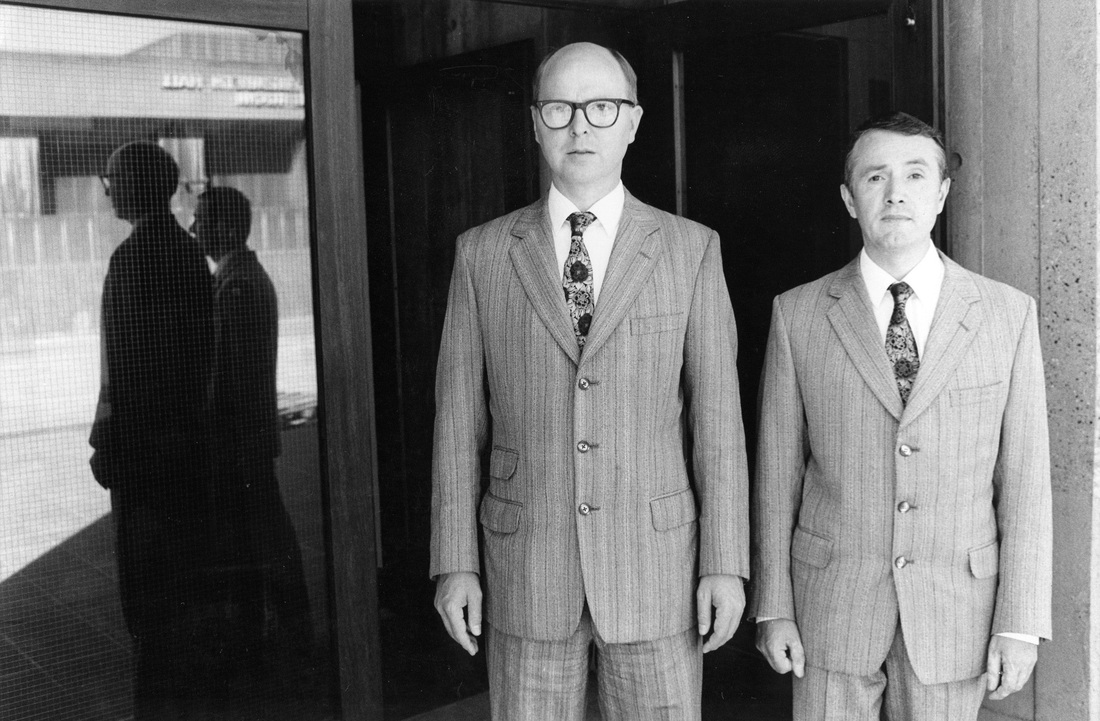‘Where’s the fucking stipend?’ read the postcard delivered to the artists Edward and Fanny Wadsworth.1 They had been supporting Wyndham Lewis with a monthly allowance throughout 1924, and the money had not turned up. Spiteful gestures were the quarrelsome Vorticist’s stock-in-trade: he was ungrateful, uncouth – jump ahead four decades and you might even say ‘unprofessional’. According to the rubric laid down in 1969 by Gilbert and George in ‘The Laws of the Sculptors’, artists should ‘always be smartly dressed, well-groomed, relaxed, friendly, polite and in complete control’.
Leap forward in time again to north-east London, 2009. Forty years on from provoking the flower children with their smartly tailored suits, metallic faces and lost nights with a bottle of mother’s ruin, every evening Gilbert and George walk past the end of my street, marching the three miles between their home in Spitalfields and the Mangal II Turkish restaurant in Dalston, where they sit at the same table for their dinner. Whenever I catch a glimpse of them, I can’t help thinking that their look – that of respectable English gentlemen, commonly taken to be an ironic counterpoint to the sexual and scatological themes of their work – appears to communicate a sincere statement of intent: of always being ‘on’, still 100 percent committed to a total life project begun in the 1960s. I wonder what they make of today’s contemporary art scene compared with that of their art school days. Despite the astronomical price of property, the east London they inhabit is reportedly home to the highest density of artists in Europe: there are some 54 galleries in this part of the city alone (for the last ten years, a sign painted by students in the style of Bob and Roberta Smith and affixed to a house on east London’s Hackney Road has declared that ‘EAST IS THE NEW WEST’). London is also, of course, home to Tate Modern, one of the country’s biggest tourist attractions, and every autumn the city hosts a number of high-profile art fairs: Frieze, Zoo, Scope. This year may turn out to be the year in which gallery closings are the new openings and ‘told you so’ schadenfreude is the new market optimism. But could Gilbert and George, as young men at St Martin’s School of Art in the late 1960s, have imagined a time such as now, when the word ‘creative’ is used more as a job title than as an adjective?
-READ MORE: http://www.frieze.com/issue/article/a_serious_business/
Leap forward in time again to north-east London, 2009. Forty years on from provoking the flower children with their smartly tailored suits, metallic faces and lost nights with a bottle of mother’s ruin, every evening Gilbert and George walk past the end of my street, marching the three miles between their home in Spitalfields and the Mangal II Turkish restaurant in Dalston, where they sit at the same table for their dinner. Whenever I catch a glimpse of them, I can’t help thinking that their look – that of respectable English gentlemen, commonly taken to be an ironic counterpoint to the sexual and scatological themes of their work – appears to communicate a sincere statement of intent: of always being ‘on’, still 100 percent committed to a total life project begun in the 1960s. I wonder what they make of today’s contemporary art scene compared with that of their art school days. Despite the astronomical price of property, the east London they inhabit is reportedly home to the highest density of artists in Europe: there are some 54 galleries in this part of the city alone (for the last ten years, a sign painted by students in the style of Bob and Roberta Smith and affixed to a house on east London’s Hackney Road has declared that ‘EAST IS THE NEW WEST’). London is also, of course, home to Tate Modern, one of the country’s biggest tourist attractions, and every autumn the city hosts a number of high-profile art fairs: Frieze, Zoo, Scope. This year may turn out to be the year in which gallery closings are the new openings and ‘told you so’ schadenfreude is the new market optimism. But could Gilbert and George, as young men at St Martin’s School of Art in the late 1960s, have imagined a time such as now, when the word ‘creative’ is used more as a job title than as an adjective?
-READ MORE: http://www.frieze.com/issue/article/a_serious_business/
